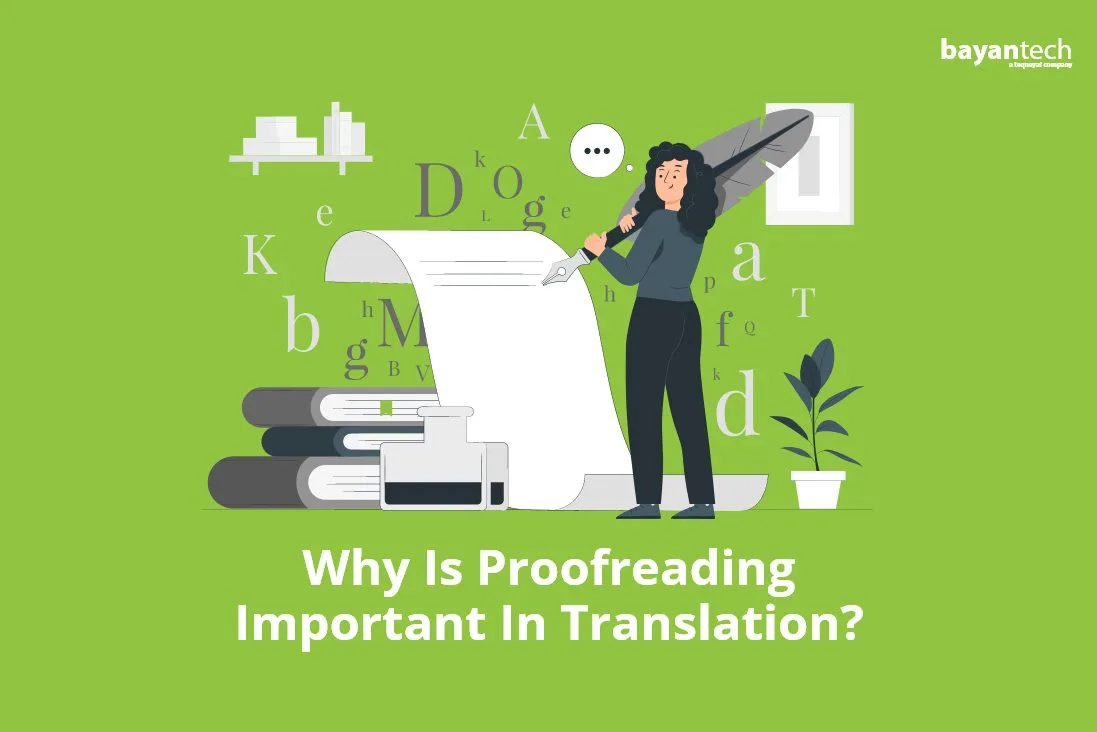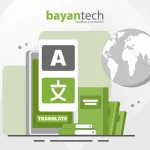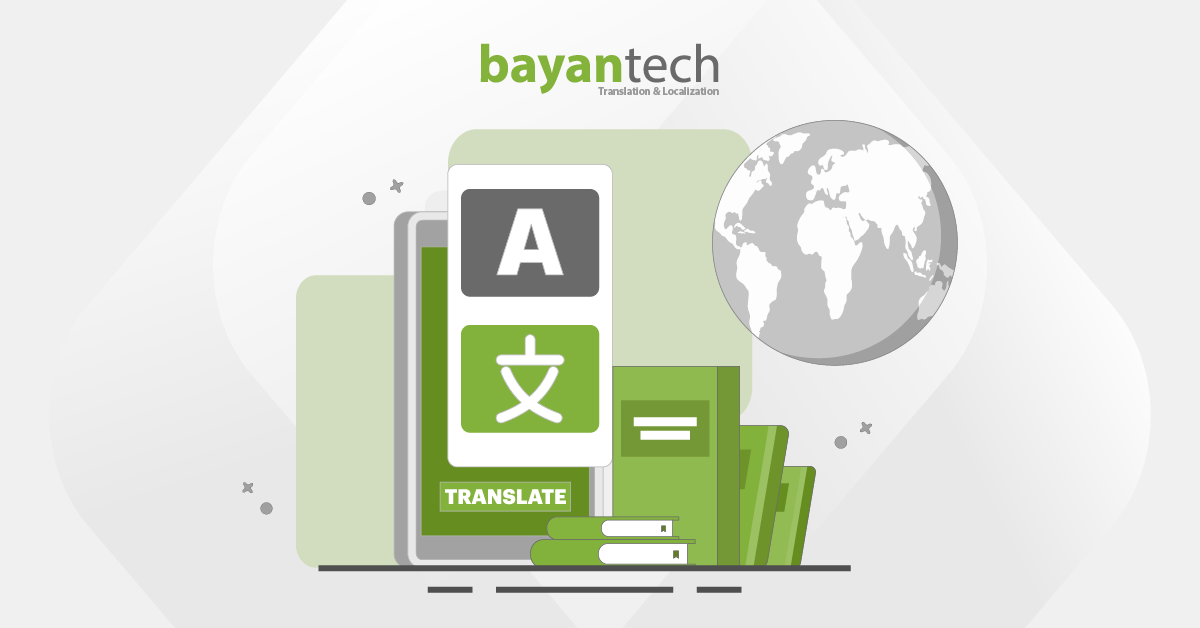Whether you’re translating marketing materials, academic papers, or technical documents, you want to make sure that the final version is clear, accurate, and communicates your message effectively.
But maintaining precision gets exponentially harder as content moves from one language to another. Nuances can slip through the cracks, incorrect assumptions arise, and mistakes can confuse, annoy, or dissuade if left uncaught.
And it’s not just about quality in itself. It’s the impression you leave on your international clients, partners, or audiences with flawed content.
That’s the power of proofreading in translation.
Keep reading to learn more about the role of proofreading in translation, how it is different from editing, and tips for choosing your right translation partner.
So ready to get started?
Table of contents
- First Things First: What Is Proofreading?
- 5 Key Aspects of Proofreading in Translation
- A Quick Proofreading Checklist for Translation Projects
- Editing vs Proofreading
- Taking Care of the Proof: Why Is Proofreading Important?
- 5 Tips to Choose An Expert Language Service Provider for Proofreading Services
First Things First: What Is Proofreading?
Proofreading in translation is the meticulous process of reviewing and refining translated content, serving as a final quality control checkpoint before the translated material (is submitted to the client) reaches its intended audience.
A common misconception is that proofreading involves a mere word-by-word revision for spelling, grammar, and punctuation. However, proofreading is more sophisticated and intricate than this.
5 Key Aspects of Proofreading in Translation
- Linguistic Accuracy: Proofreaders review to ensure adherence to grammatical rules, syntactical structures, punctuation, and spelling conventions of the target language, identifying ambiguities and disruptions in the flow and committing to the content’s clarity, consistency, and readability.
- Faithfulness to Source Material: Proofreaders verify that the translated content completely and faithfully conveys the original message’s intended meaning and captures the source text’s tone, style, and mood.
- Cultural and Contextual Relevance: Proofreaders ensure that culture-specific language and terms, such as idioms and metaphors, are appropriately adapted to resonate with the target audience.
- Style and Formatting: Proofreaders check for consistent fonts and typography, proper paragraph indentation and line spacing, formatting, alignment, and proper source citation.
- Adherence to Brand Identity: Proofreaders align the content with the brand’s guidelines, in terms of tone and voice, consistent usage of the brand-specific language preferences, writing style, visual elements, color palette, and layout.
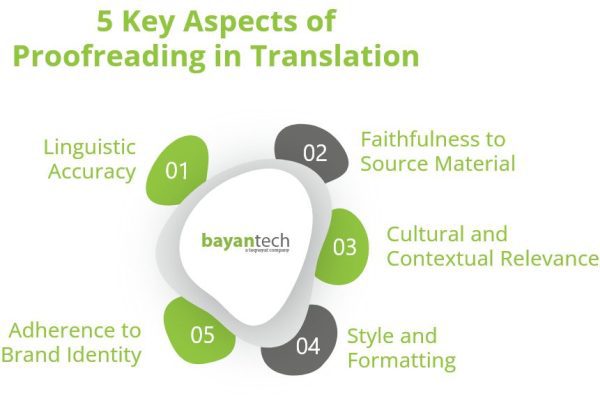
This makes proofreading a comprehensive approach that delivers clarity, coherence, cultural appropriateness, and the overall quality of the content while maintaining the intended meaning and most importantly your brand voice and identity.
But what happens exactly during the proofreading process? — Here is a more detailed overview of proofreading.
A Quick Proofreading Checklist for Translation Projects
- Correcting grammatical, vocabulary, and syntax errors in the target language.
- Ensuring consistency in terminology, style, and tone throughout the translation.
- Verifying the accuracy of cultural references and idiomatic expressions.
- Checking for formatting and typographical errors.
- Reviewing the translated document for coherence, clarity, and accuracy.
- Making changes to improve the flow and readability of the translation.
- Verifying the accuracy of specialized terminology or subject-specific terminology.
- Addressing any potential mistranslations, ambiguous phrasing, or cultural inaccuracies.
- Collaborating with translators to resolve any translation-related concerns or questions.
Editing vs. Proofreading
Proofreading is just one stage of editing, and an efficient proofreading process is impossible unless editing is done properly. While the editing process supervises every part of the translation, proofreading comes to complement it, looking into the tiniest details that editors may have left out.
Let us have a quick glimpse into Copyediting vs. Proofreading
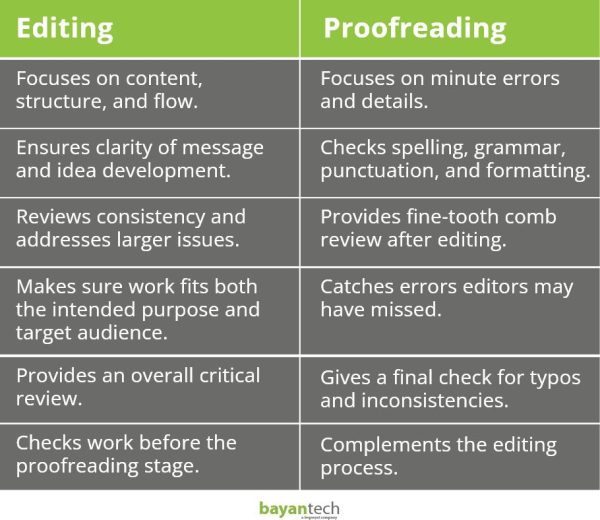
Why are ISO Certified Translation Agencies the Best in Proofreading?
We created a quick guide explaining everything you need to know about it.
Taking Care of the Proof: Why Is Proofreading Important?
When you work with a translation company, you want to ensure the highest quality output. But while it takes exceptional language skills and deep industry knowledge to deliver high-quality translation, proper proofreading is also critically important.
A trusted translation partner will understand that proofreading services are a necessity, as minor errors can undermine your messaging or damage credibility with international audiences.
And that is why It is crucial to select a translation provider that implements thorough proofreading as part of their translation process.
Let us dive deeper into why proofreading needs to be an integral part of the translation process and how it can add value to your content.
- 1. Ensures Your Message Is Clear
Proofreading the translated content is indispensable for ensuring your core message comes through clearly in every target language.
When your content is translated without a subsequent proofreading step, there is a risk that nuances could be lost or meanings misconstrued.
Proofreading, as an extra quality check, takes a close look at grammar mistakes and problems in style, readability, and visual presentation to flag any areas where the logical flow or structure of ideas is obscured.
Translation companies that leverage professional native proofreaders as part of their process deliver maximum clarity. These proofreaders can identify even subtle issues with terminology, cultural references, or critical details that – if mistranslated or phrased unclearly – can be confusing.
So, choosing a professional translation service that utilizes proofreading in its translation workflow ensures that the output will captivate your customers, rather than frustrate or discourage them from receiving your intended message.

- 2. Protects Your Brand Reputation
When expanding into new markets, the last thing you want to evoke is unprofessionalism or questioning of your brand’s reputation for quality.

Going global requires finesse and proofreading your translated business materials is paramount to preserve the carefully crafted image and values that drew customers to your brand originally.
International audiences will form impressions of whether a company is truly professional based on the smallest of details. Translation errors, grammatical mistakes, and inconsistent messaging can cast doubt on how seriously a brand takes its global expansion.
Know that your global customers expect the same polished experience you provide domestically, just localized for their culture. And you can never deliver that when you rely on low-quality translated materials to represent your brand.
Working with a translation company that carries out comprehensive proofreading for your translations
- Ensures that international customer interactions and communications will maintain the high standards your brand has set.
- Guarantee that your brand’s reputation remains strong as its reach grows – which is critical for long-term success in new territories.
- 3. Maximize Your Translation Investment
When you make an investment in translation, you rightfully expect to reap its full benefits without the hassle and additional costs of revisions or re-translations. And this can only be achieved with the power of proofreading.
Proofreading your translations helps to catch any errors or inconsistencies early so that edits are not required, which means avoiding excessive additional costs down the line.
This proactive approach not only streamlines your translation process but also safeguards your investment, ensuring that you receive the highest quality output from the very beginning.
Not only this but proofreading can also contribute to the longevity of your content’s return on investment (ROI). When your translations are meticulously proofread, they become a valuable asset that can be reused and distributed for an ongoing impact.

- 4. Ensures Effective Optimization Of Your Digital Content
Proofreading is the unsung hero that can truly elevate the performance of your translated digital content. But how?
By meticulously reviewing and refining your translated text, proofreading helps to eliminate inconsistencies and linguistic inaccuracies that could hinder the performance of your content online.
It ensures that your digital assets, such as website pages, blog posts, social media content, and marketing materials, are polished and error-free, enhancing user experience and engagement, which translates into better ranking in search engine results.
Search engines prioritize high-quality content that delivers a seamless user experience, and by investing in proofreading, you enhance your chances of achieving higher rankings, increased visibility, and improved organic traffic.
With each word carefully scrutinized and polished, your translated content becomes a powerful asset in your SEO arsenal, propelling your digital presence and success to new heights.

- 5. Guarantees Precision & Accuracy For Critical Content
The highly-specialized nature of critical content like medical, legal, and technical documents necessitates the need for utmost precision and accuracy when translating them into different languages.
This is because even minor errors in these materials can have serious consequences—from adverse health outcomes to legal trouble and financial loss.
A meticulous proofreading process helps catch any lingering mistakes in terminology, formatting, grammar, or adherence to guidelines—inconsistencies that could undermine or distort the meaning of complex, regulated information.
Whether scrutinizing the details of a clinical trial manuscript, the language of a binding contract, or the steps in a technical manual, proofreaders provide an essential quality check.
Proofreading adds an extra layer of protection for high-stakes writing, verifying the accuracy of every component which is the core of translating in these highly sensitive domains.
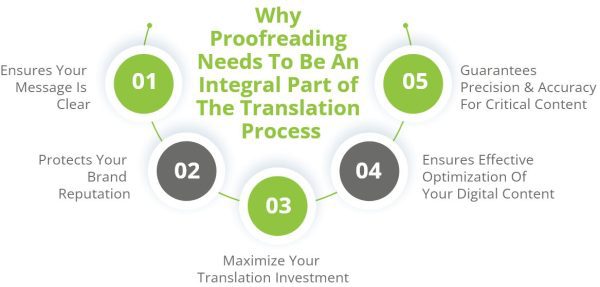
Why You Need Business Translation For Your Internal Documentation
Choosing a language service provider that adheres to the highest quality standards is crucial for guaranteeing accuracy in your translations. When evaluating providers, look for these markers of excellence:
- 1. Native Language Experts
Work with a provider that only uses in-country translators who are native speakers of the target language. Fluency in the nuances of the language is needed to convey the correct meaning.
- 2. TEP Translation Process
The best providers follow a translation, editing, and proofreading (TEP) process. Separate editors review and refine translations before a proofreader gives a final quality check. This layered review ensures consistency and eliminates errors.
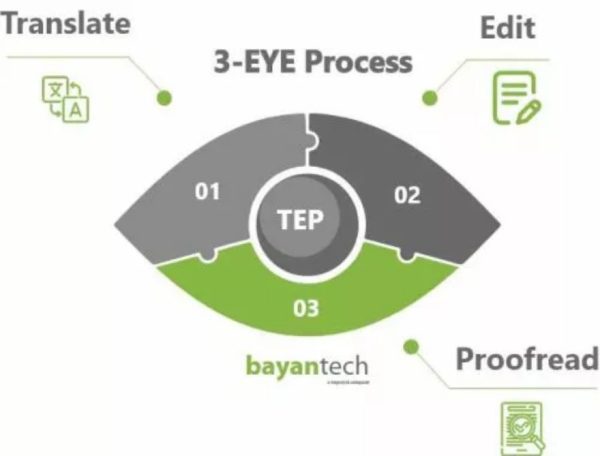
- 3. Advanced Translation Tools
Look for advanced tools like translation memory software that stores previous translations to aid consistency across projects. Other tech aids like terminology management and glossaries also optimize quality and efficiency.

- 4. Subject-matter Expertise
Choose linguists with background knowledge in your specific industry for the most accurate technical and industry-specific translations. Their expertise ensures a full understanding of key concepts and terminology.
- 5. Rigorous Quality Assurance
Stringent quality assurance at every step is vital. Quality benchmarks, like customer reviews, service guarantees, and certification, are indicators of a solid quality assurance program.
Sign up to our newsletter to receive the latest blogs and news.
8 Steps Every Medical Interpreter Takes
Looking for a medical interpreter? Discover the career path of medical interpreters and qualifications they need to acquire to take on interpreting jobs.
bayantech: Your Committed Translation Partner
At bayantech, we truly understand how critical proofreading is for ensuring high quality. And being ISO 17001 and 9001, you can trust us to apply the highest standards of translation quality control to your projects.
With bayantech proofreading services, we assure you that all of our translations go through a rigorous three-step review process where content is translated, edited, and proofread by different linguists. They are native translators and editors who have the language and subject-matter expertise to identify and address any errors, inaccuracies, or areas needing revision – so you receive a translation you can fully rely on and confidently release to your intended audience.
Let’s discuss your translation project. Contact us or request a free translation service quote.

